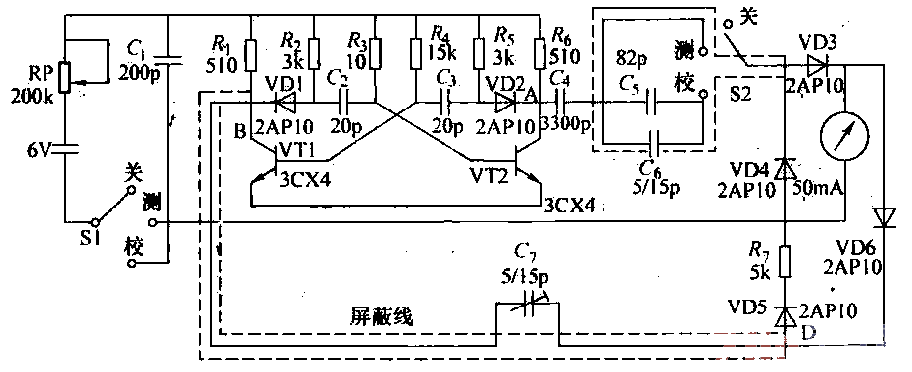Grain moisture analysis circuit
Source: InternetPublisher:已注销 Keywords: BSP Updated: 2020/01/11

(1) Working principle Practice has proved that when the moisture contained in grain or oil is different, its electrical properties are different.
If the test container is made into a metal cylinder and a stem is added to form a measuring cylinder, a capacitor is formed. After loading the grain or oil to be tested
into the cylinder. Its dielectric is no longer air, but uses grain or oil as the dielectric of the capacitor.
Everybody knows. The capacitance of the capacitor is proportional to the dielectric constant of the dielectric. Different types of grains or oils have different dielectric constants
. The greater the moisture content of the same grain, the greater its dielectric constant.
Therefore, the measuring tube is connected in series in the circuit (equivalent to a capacitor), and by measuring the current intensity in the circuit, the capacitance of the measuring tube can be known
(the greater the current, the greater the capacitance), thereby indirectly measuring the grain (or oil) moisture content.
(2) The electrical schematic diagram
is shown in Figure 5-4'3'}
An ordinary multivibrator is used as the signal
source in the circuit, and the output signal frequency is about
2MH;o;. . (There are
two signal output terminals A and B.
The signals output by terminals A and B have
opposite phases). During production, the parameters of the multivibrator
components are required to be as symmetrical as possible
. The values of VT1 and VT2
are preferably 25 to 35, and the fixed
resistors are all made of metal film resistors. RP mostly uses wire-wound resistors, and C6 and c7 use small air dielectric variable capacitors. To reduce interference, AC and
BD lines should be metal shielded lines. The tester casing should also be made of metal . The outer cylinder of the measuring cylinder (one pole of the measuring cylinder capacitance) has a diameter of 50mm and
a height of 50mm. The inner column (the other pole of the measuring tube capacitance) has a diameter of 10mni and a height of 50mm. The bottom plate of the measuring tube is made of plastic or organic glass, and
the outer cylinder and inner column of the measuring tube must be drilled and fixed on the bottom plate. Then weld a wire from the bottom of the outer cylinder and the inner column as the measuring cylinder G.
The upper part of the measuring cylinder is also connected with a bell mouth for pouring grain or oil. The entire circuit is installed on a 5cm × 4cm printed circuit board
. After confirming that it is correct, start adjusting. Disconnect C2 and C3 first. Measure the voltage between c and e of rr'l and VT2 . Normally around 3V. If the C and E poles of the two tubes
have the same voltage and are relatively high, the resistance values of the product and wind should be appropriately reduced until they are normal.
Then weld the island and C1. Then measure the voltage between the c and e poles of VT1 and VT2 . If it is around 3V, it means that the oscillator has started to oscillate. Then adjust G and
G, first adjust to the middle value, move K2 (note: Kl, K2 is actually a double-pole, three-throw rotary switch) to the "test" position, adjust G. Return the head
pointer to the "o" position.
Then dial K2 to the "calibration" position, adjust C6 and w (potentiometer) to deflect the meter needle to full scale, repeat several times until K2 is dialed to the
"measurement" position, and the meter pointer returns to the "0" position; dial to the "4 school" position, and the meter hand deflects to full scale. Then dial K2 to the "test" position,
pour the grain or oil to be measured into the test tube, and the pointer on the meter head should slowly deflect to the right. The greater the moisture content, the greater the deflection angle. The adjustment is complete.
The meter dial can be made as follows: First, measure several grain varieties that often need to be measured. Such as rice, wheat: soybeans,
corn, sesame, peanuts and other samples with moisture content between io% and zs%. Capacitance value (draw 6 arcs of 904 arcs on the dial, and the divisions represent the above 6
grain varieties), and mark the corresponding positions on the dial as the calibration standard. The scale between the two samples can be divided into Draw by the measuring method,
so that the tester is basically completed.
After the completion of the production, turn K2 to the "measurement" position, pour the grain or oil to be measured into the measuring cylinder, and the moisture content can be read from the deflection angle of the meter needle
.
- Electromagnetic radiation monitor
- DIY Metal Detector
- Homemade refrigerator monitor
- Homemade Metal Detector
- Design of wireless meter reading system based on DSP
- Infrared detector
- Circuit Fault Tracker
- Four logic probe circuit diagrams
- Fluorescent tube inverter circuit and emergency lighting circuit 02
- Three-phase three-wire active energy meter connected to three ammeters
- Motor overcurrent protection circuit
- Excellent performance household inverter power supply circuit
- Agricultural spraying and insecticide control circuit
- Farmland irrigation automatic control circuit b
- AC voltmeter
- Integrated synchronous detector composed of analog multiplier MC1596
- Parallel crystal oscillator
- Differential Amplifier Circuit
- Voltage-controlled voltage source second-order active low-pass filter circuit
- Guest arrival signal recognition circuit







 京公网安备 11010802033920号
京公网安备 11010802033920号